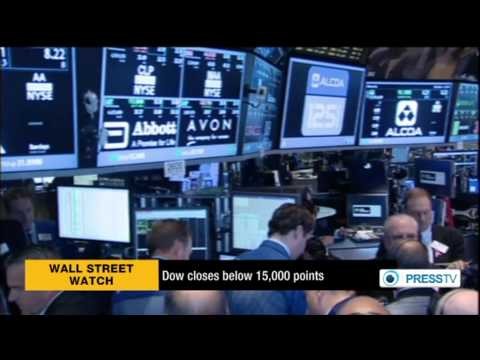A nauseating day for Wall Street as stocks plunge Business
Post on: 25 Апрель, 2015 No Comment

MARKO GEORGIEV/STAFF PHOTOGRAPHER
Traders sold riskier investments and moved money into U.S. government bonds, gold and cash on Wednesday. Analysts hope the day’s steep drops mean the markets are closer to a long-awaited 10 percent correction.
* Dow plunges 460 points before recovering as fears of a global slump intensify
NEW YORK — Fear drove Wall Street to one of its most dramatic, nauseating days in years on Wednesday.
Investors fled stocks and poured money into bonds as worries about a global economic slowdown intensified. The Dow Jones industrial average dropped 460 points in early afternoon trading, all three U.S. stock indexes were in negative territory for the year and the so-called fear index surged.
A late recovery limited the damage and left stocks mostly lower. But investors were shaken after the heaviest day of trading in more than three years.
I think it’s fair to call it a global growth scare right now, said Bill Stone, chief investment strategist at PNC Asset Management.
Investor concerns of a worldwide economic slowdown turned into outright fear after weeks of turbulence. Germany, Europe’s biggest economy is struggling. Greece, a key actor in Europe’ debt crisis three years ago, could see its government collapse next year, putting a crucial bailout program in danger. A batch of worrisome economic news in the U.S. also fueled the selling.
Traders sold riskier investments and moved money into U.S. government bonds, gold and cash.
By the end of the day, the Dow Jones industrial average lost 173.45 points, or 1 percent, to 16,141.74. The Standard & Poor’s 500 index lost 15.21 points, or 0.8 percent, to 1,862.49 and the Nasdaq composite dropped 11.85 points, or 0.3 percent, to 4,215.32
The yield on the benchmark U.S. 10-year note fell from 2.20 percent to below 1.91 percent. By the end of the day, it pulled back to a yield of 2.14 percent. The yield on bonds moves in the opposite direction of stock prices.
It typically takes weeks for 10-year Treasurys to move 29 basis points, said Tom Di Galoma, head of fixed income rates in New York at ED&F Man Capital. Today it moved 29 basis points in 5 minutes.
Stone said he thought the plunge in bond yields likely played a role in the stock market’s steep drop in early trading.
I don’t care who you are: to see the 10-year [bond] near 2 percent is shocking, he said.
Investors have grown nervous of a stock market that had pushed ever higher, even in the face of a weakening global economy. The U.S. market has also not had a correction, a technical term for when a stock or index falls 10 percent or more, in more than three years. Historically a correction happens every 18 months.
Wednesday’s slide brings the market closer to that long-predicted but elusive correction.
Investor sentiment has clearly been pummeled of late as some signs of surrender are forming,» Tobias Levkovich, Citigroup’s chief U.S. equity strategist in New York, wrote in a note Wednesday. While no one ever rings a bell at the bottom and there is not generally a cathartic, cataclysmic crescendo of capitulation, fear is emerging which intimates that a floor may be within reach.»
Michael Binger, senior portfolio manager at Gradient Investments, said that investors may have started to step back into the market in the last hour of trading as the S&P 500 approached a drop of close to 10 percent from its record close of Sept. 18.
The market has been waiting for this 5 to 10 percent correction for quite some time, and we got it, he said.
Many market watchers say occasional corrections are a healthy phenomenon over the long term and give investors an opportunity to add to their holdings at a lower cost.
That’s why it’s so important to stay invested at a time like this, rather than think it’s a time to get out, said Kate Warne, an investment strategist at Edward Jones.
It’s not the U.S. economy that investors are worried about, at least not yet. It’s everyone else’s. Last week markets sold off sharply after the International Monetary Fund cut its economic forecast for the global economy, noting the weakness in Europe and in Asia.
The U.S. economy remains in recovery mode. U.S. employers are hiring at the strongest pace in 15 years. The economy expanded at a 4.6 percent annual rate in the April-June quarter and most economists forecast growth will be a healthy 3 percent this year and next.














